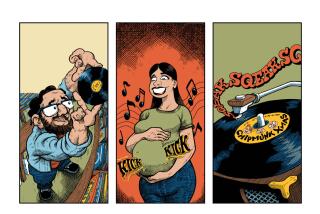A TALE OF TWO CD’S
- Share via
Developments and views on the Home Tech front.. . .
As anyone with a new compact-disc player knows, supplying the new gadget in the house takes big bucks. CDs run about $15 and imports can cost more. So if you’re on a budget, the even higher cost of a double-disc CD--often twice the usual rate--can make a serious dent in the bank account. Consider the questions raised by a release like sometimes Police-man Sting’s new concert album, “Bring on the Night.”
The double-album is not a sound track from the Sting documentary of the same name, but consists of recordings from other dates late in the same tour (with jazz-oriented musicians including Branford Marsalis). A&M; is marketing the album in Europe but has no plans for an American release. However, the LP and a CD version (to be reviewed in a coming Tuesday Home Tech column) can be found in better-import racks.
That brings up a question for those who might prefer the compact disc. It’s one of the more expensive, double-disc kind, but it didn’t have to be-- if some of the music from the album had not been included.
The album’s playing time totals 82 minutes and 44 seconds (surprisingly including neither “Russians” nor “If You Love Somebody”). Since the maximum amount of playing time on a compact disc is 72 minutes, the Sting CD needs two discs to contain all of the music.
If one or two songs could be cut from a double album to make it fit on one CD, selling for $10 to $15, would that be preferable to paying so much more for a double-disc CD just to get the entire album? If it’s a matter of 10 minutes, as with the Sting album, should the record company edit 10 minutes out? What if an album contains 75 or 76 minutes, meaning only three or four minutes would have to be cut?
If anyone thinks a record company wouldn’t trim an album for this purpose, consider the sound track for the musical film “Absolute Beginners.” Three songs on the 21-track European double-album version are missing from the import CD to make it a single-disc release.
DISC DRIVE: A compact-disc player in the home simply isn’t enough for some people. They want CDs on wheels, too. Happy to oblige, the consumer-electronics industry has introduced car players that can be installed. However, new-car shoppers expecting to find CD players as included or optional equipment are in for a shock.
So far, only one automobile sold on the U.S. market, the Mazda RX-7, offers an optional AM/FM/CD unit, which adds $695 to the cost of the approximately $15,000 import. But the RX-7 won’t have the wonders of digital sound all to itself for long. Ford will equip its new Lincoln Town Cars with CD players (due in August) and don’t be surprised if other auto manufacturers rush compacts into compacts (and bigger cars) this fall, too.
“RAMBO,” “GODZILLA ‘85,” AND A MARS BAR, PLEASE: The newest twist in renting videos is sweeping Japan, where you can walk up to a vending machine, stick in a plastic card, punch a few buttons, and--plunk--out comes a video.
Will video-hungry America go without such a convenience? Not for long, it seems. An Arlington Heights, Ill., company called Video Express International has developed a video-rental machine. Something like those automated bank tellers, the V-600 displays directions on a screen and is triggered by a piece of encoded plastic--in this case the company’s membership card. Featuring “easy-to-use, one-hand, three-step” operation, the “consumer-friendly” machine also has a 12-inch color monitor that can show selected previews and promotions.
The entire transaction isn’t supposed to take more than a minute. It’ll be a great solution if you get a hankering for a movie at 2 a.m., when the video stores are closed. Whether these gadgets will catch on in Southern California and elsewhere, though, remains to be seen. If they do, get ready for the dark side of video vending. In Japan, if you don’t get the cassette back to the machine within a week, you’ve bought yourself a video.
More to Read
The biggest entertainment stories
Get our big stories about Hollywood, film, television, music, arts, culture and more right in your inbox as soon as they publish.
You may occasionally receive promotional content from the Los Angeles Times.









